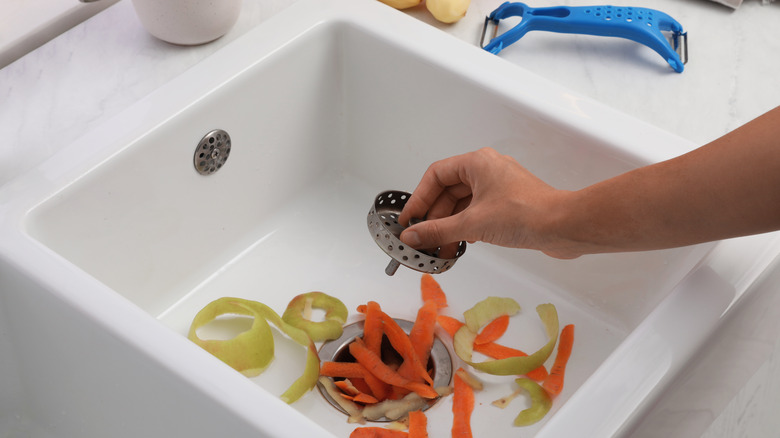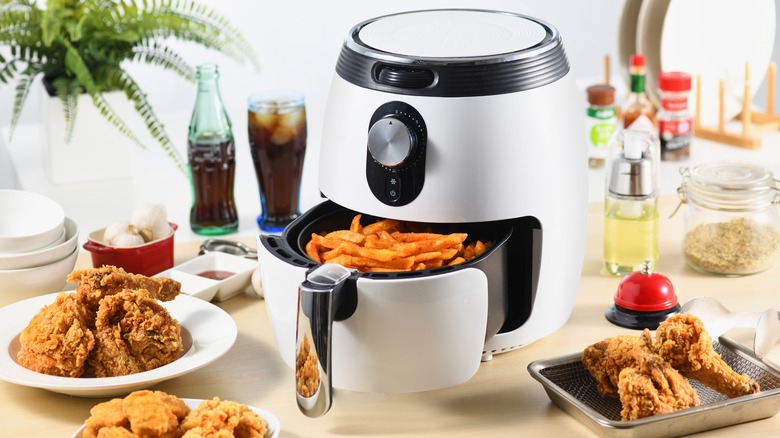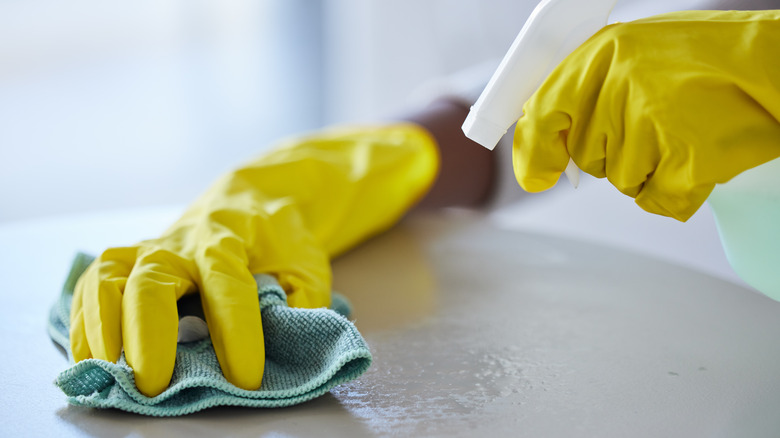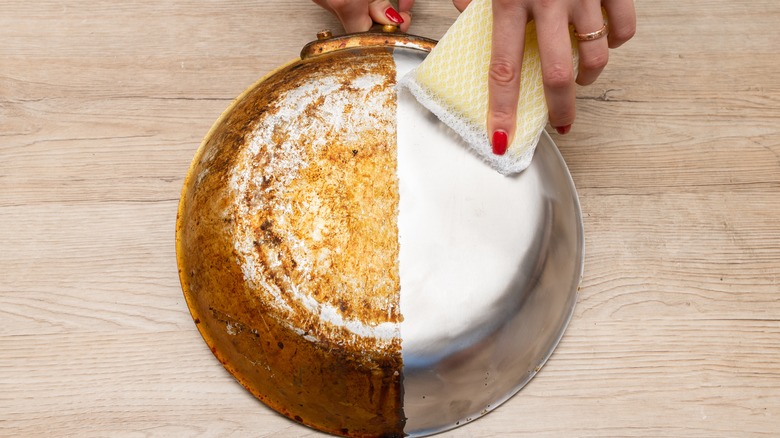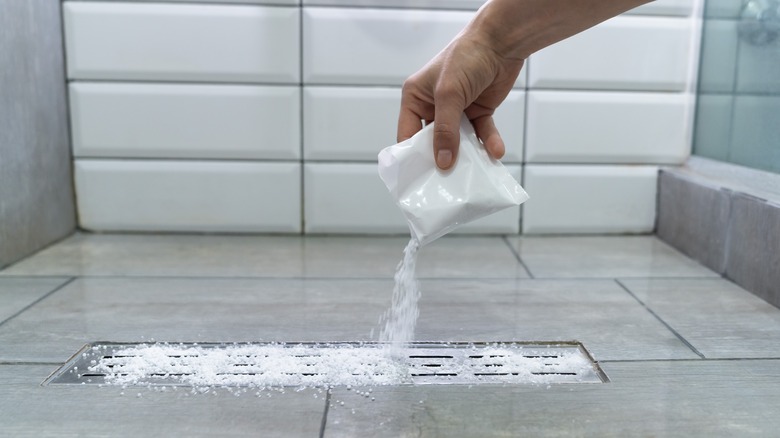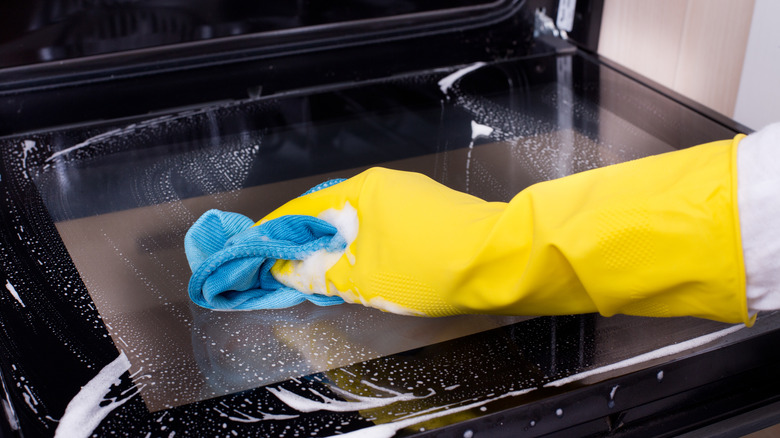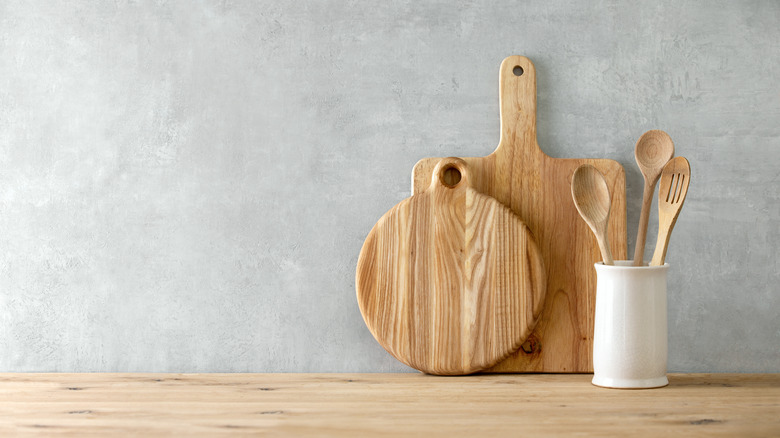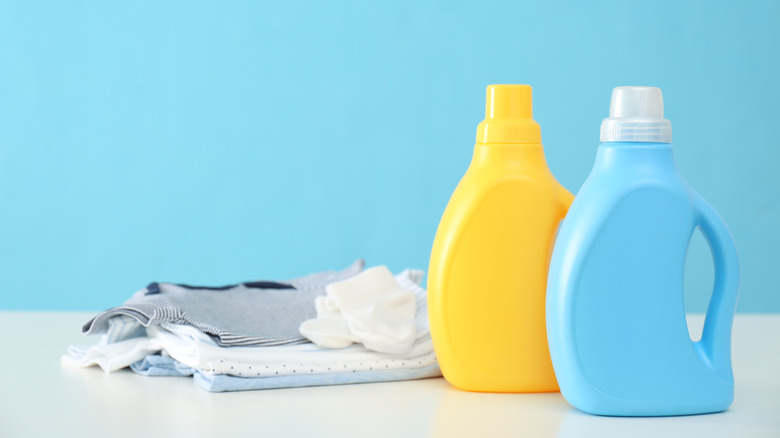The Best Spring Cleaning Hacks From TikTok That Will Get Your Home Fresh In No Time
We've all been there – scrolling through TikTok when we should be asleep. Sure, most of it is digital chefs making delicious quick meals; mindless funnies, and cute dogs and cats doing cute dog and cat things. Occasionally, however, we stumble upon the wonder of #CleanTok — a magical land where cleaning hacks designed to make your cleaning experience more palatable are made. On #CleanTok, one product can be used for multiple purposes. You can even create your own concoction to eliminate stains and odors. This side of TikTok is like watching a live experiment take place.
When it comes to cleaning, many of us would much rather sit on TikTok than actually get to work. It's a chore — we get it. But what if we told you there were some ingenious tricks to make cleaning easier and even more fun? Right at your fingertips! Whether it's the dishwasher soap and hot water mix that claims to get every bit of burnt food out of your air fryer. Or the miraculous simplicity of getting pet hair off your couch using one household item (this one might surprise you). Whatever your cleaning problems, there is likely an exciting solution. Here is a list of hacks that don't require much more than the products you have at home and will make your spring cleaning a breeze.
Using aluminum to give your silverware more shine
The premise is simple: Scrunch up some aluminum foil and place it in your dishwasher to give your cutlery a better shine. If you're anything like the comments section for this hashtag, on poster Carolina McCauley's page, you might have some questions. "How?" Or, "Isn't that toxic?" And maybe, "Can't you just use bleach?" and so on. Well, here's how it works.
For many people, signs of wear and tear manifest in metal cutlery through scratches and a dullness you might struggle to get rid of. This TikTok hack positions itself as a simple solution to that problem – and it won't cost you more than a few bucks. Simply ball up a small amount of aluminum foil and place it in the cutlery compartment of your dishwasher. Add your dishwasher soap as normal, and close. Leave to wash as usual. When it's done, your cutlery should be good as new. In fact, you should be able to see your reflection when you pick up your spoons.
So. Does it actually work? According to blogger Hip2Save, it worked so well that it even made her glassware clear and free of scratches. Also, fear not if you're worried about the foil scratching up your dishes. The foil stays in the cutlery compartment only. There's a science to this, of course. In its simplest terms, the ingredients of the dishwasher soap, combined with the metal, cause a chemical reaction that helps to get the shine back in your silverware.
Did you know you were meant to clean your faucet aerators?
What's a faucet aerator, we hear you ask? Well, it's that nozzle at the tip of your tap that controls how much water comes out of it. This may come as a shock to you, but when your faucet aerator isn't cleaned, it can accumulate quite a generous amount of limescale and gunk. Yuck! Don't fret though, there's a simple enough hack to get rid of it without needing to call a plumber. According to Tik Toker, Madelyn Combs, all you need is half a lemon. So grab one, slice it in two, and shove them up your taps. It's best to leave it on overnight for the citrusy fruit to work its magic. It's that easy.
Of course, as with any cleaning hack, many DIY lovers tested it out for themselves. Blogger Tom's Guide discovered that the lemons didn't necessarily make the calcium buildup fall off his taps. However, it did make his taps much easier to clean. If you can't get lemons, then an alternative is to wrap your faucets in a zip-lock bag containing lemon juice – again, overnight, for similar results. You may be asking yourself, do I really need to clean my faucet aerators? Actually, yes. These nozzles are such a crucial part of ensuring that your water comes out clean and free of harmful chemicals, so it stands to reason that you'd want the passageway free of any disruptors. If there is lead anywhere in your pipeline, calcium buildup can make your taps vulnerable to it. It is advisable to clean out your faucets at least once a year to avoid this.
Clean your disposal with ice
By its very nature, the garbage disposal is a vortex of gross things. But what if there was a way to not only keep it clean but even a little fresh? Thanks to this hack by Organized Life Coach, it's possible! Viewed 3.2 million times on Tik Tok, the results, as the poster says, has us shook! Though she doesn't provide an exact amount, the Tik Toker does suggest "shoving a bunch of ice" down your garbage disposal. In her case, she uses a bowl's worth of ice cubes, pushing each one down the drain. Afterward, run cold water from your tap over the ice-clogged drain – and keep pushing all the ice down as the water runs. What happens next will likely disgust but also astound you. Brown liquid begins to come up the drain as the ice continues to melt. Keep the water going until it runs clear.
While this seems like a straightforward hack, be warned that results may vary. For writer Kalina Newman, this hack did not work. In fact, loading her disposal with ice almost broke it (via The Washington Post). In contrast to Organized Life Coach, Mr. Garbage Disposal says to run hot water instead of cold as you push the ice down the drain. The blogger also suggests turning on the garbage disposal (take your hand out first!) and letting it grind up the ice. This action, it is suggested, sharpens the blade and sweeps away leftover food.
Add a dishwasher pod and some boiling water to your air fryer
If you're an air fryer owner, you're probably willing to try anything that makes cleaning your device easier. To get rid of difficult-to-remove debris from your air fryer #CleanTok queen Carolina McCauley suggests adding a pod of dishwasher soap to it. Soak the pod and the air fryer in hot water and let it sit for 10 minutes. After that, pour out the old dirty water and rinse with cool water. You should be left with a debris-free air fryer after that.
This one seemed to be a bit divisive in the comments section of McCauley's post, but experts agree that this method works. A slightly different air fryer cleaning trick suggests actually air frying the water and soap mix. This variation of the hack, offered up by Maverick McBee, air fries the hot soapy water at 375 degrees for three minutes. This seemed to get out the muck from his unit — he did have to do it more than once due to the massive buildup of debris from irregular cleans. Using this method, Tim Macin of Mashable got to work. In his findings, he discovered that the hack got some of the residue off; he still had to wipe down the basket to get the rest off manually. Elsewhere in McBee's comment section, some users offered up a different hack for easy cleaning: parchment paper or foil.
Try this DIY dusting spray to repel dust mites
Write this down: Mix 1 cup of water, ¼ cup of vinegar, 2 tbsp olive oil, and 10 – 15 drops of lemon essential lemon oil in a spray bottle. Shake the concoction well and spritz it over your dusty surfaces. The promise is once you wipe these surfaces, you won't have to revisit them for at least a few weeks. This sounds too good to be true, so does it work? The viral video, posted by @SimpleCleanFit_Whit on TikTok, claims that the essential oils help polish surfaces and keep dust at bay longer while also repelling dust mites.
While some in the comments were sold on the idea, others needed further proof. This led to a second video by the #CleanToker, in a bid to prove the validity of her homemade cleaning concoction. In the second video, the user sprayed the mixture around the dusty corners of her washing machine and dryer. This is one of several similar hacks to combat dusty surfaces. Another option, according to Confessions of an Overworked Mom, is to add olive oil or coconut oil in addition to the other ingredients. It's important to note that since this mixture contains no preservatives, it's advisable only to make a small amount at a time to avoid wasting your ingredients. Store in a cool place – a refrigerator works best – and shake well before use.
Baking soda and hydrogen peroxide to rid your pans of those pesky stains
Sometimes, the stains on the base of our pots and pans are a badge of honor, proof that you've used your kitchen utensils for their purposes. Other times, they're an annoying reminder that your stuff could look cleaner. TikTok user I Suck at Cleaning has the solution for the pesky stains that taint our pots and pans. By mixing baking soda and hydrogen peroxide — a liquid chemical combination of water and oxygen, found in many bleaches — you can achieve a much cleaner base for your cookware.
Begin by spraying the base of your pan with hydrogen peroxide; after that, pour a generous amount of baking soda to cover the entire base. Over the baking soda, spray another layer of hydrogen peroxide, then let sit for 10 minutes. Spritz some of the peroxide on a dry sponge and scrub. The TikTok user credits the book "Chemistry Hacks for Home and Outdoors" for this hack. Baking soda is a recurring cleaning solution because of its abrasive nature and whitening agents. Hydrogen peroxide is a great complement to that as it acts as an effective disinfectant. As with many of these hacks, you'll have to try it out to see if it works for your utensils. One writer found that the formula didn't help her browned pans and pots, even after much scrubbing. However, this YouTuber successfully demonstrated how the combination works.
This hack is an easier way to clean your shower drain
One of the more unpleasant chores to do in the home is unclogging the shower drain. There you find all sorts of horrible debris. So this hack, courtesy of Pure Wow (originally posted by My Aspirational Life), which doesn't require you to pull anything out of the drain at all, could be a lifesaver for the easily disgusted. It involves boiling hot water, half a cup of baking soda, a quarter cup of salt, and a cup of vinegar. Be sure you get all of it in the drain for maximum effectiveness.
This method eliminates the need for chemical-filled cleaning products, which could cause damage to your pipes if used frequently and over a long period of time. Thanks to the inclusion of baking soda and vinegar, your pipes can be protected from such a breakdown. However, you need to be mindful of the types of drain pipes you have. PVC pipes – polyvinyl chloride, which, when combined with a plasticizer, becomes a strong material for piping – are designed for either hot or cold water to pass through.
If you live in a new-build, the chances of you having PVC pipes running through your home are high. Pouring boiling water down the drain could compromise the integrity of your pipes, damaging them. Much like using chemicals frequently, pouring boiling water down your pipes consistently can, over time, weaken the glue often used with these pipes. With great hacking power comes great hacking responsibility. Only use this hack every once in a while to avoid long-term damage. And, as always, be very careful when dealing with boiling water. Safety first!
Use your latex gloves to get rid of pet hair
What was the world before latex gloves? It's hard to imagine a world without these rubber wonders. And just when you think you've discovered every use for them, something new pops up. This ingenious hack courtesy of Felicia Wilson – who rescues and transports animals for a living – could save you a pretty penny and a lot of time as well. Using only a damp glove, you can gather all the pet hair on any fabric surface. Yes, you read that right. There is no need for fancy pet hair removal products, or all you need is a pair of latex gloves and a couple of minutes.
With so many ways to get rid of pet hair, how can one be sure that this one actually works? In addition to Wilson's TikTok, which has amassed over 600,000 views, others have tried it for themselves. One commenter, @thequeernurse05, regretted wasting much of their lint roller on this endeavor. Another user, @1990aria, exclaimed, "... I've been looking for a solution that isn't pricey, and you just answered my prayers." When using this hack, it's best to go in one direction to ensure you don't spread the hair around. What's great about this hack is that you can use other rubber options to achieve similar results. A squeegee is another great way to get pet hair off your furniture.
Clean your oven overnight with this hack
Thanks to TikTok user, Mama_Mila, there's a new way to get your oven clean while you sleep. The first step involves grabbing half a cup of baking soda – the MVP of cleaning hacks. Mix the baking soda with one tablespoon of dish soap and water to create a paste. Before you begin, remove your oven racks and soak those in warm soapy water. This hack is focused on the interior walls and floor of your oven.
According to Mama Mila, you want to spread the paste thinly all over the inside of your oven and leave it overnight. While leaving this paste on overnight is great, remember to wipe down your oven racks before you call it a night. When you get up, wipe down your oven using white vinegar to remove any remnants. As with most, if not all, hacks on this list, eliminating chemicals is one of the goals. With this trick, you are able to save your oven and, indeed, your meals, from chemical intrusions. Baking soda's mild alkalinity gives it a ph of 9, which is great for counteracting acids. This is essential for breaking down oven grease and food particles, which are usually acidic. As Mama Mila points out, dish soap is a great way to soften oven grease, making it easier to wipe off.
It's important to note that more than laying the paste on and leaving it overnight is required. The next day, you'll need to do a bit of scrubbing to make sure all grease and debris are removed. So have a sponge with one soft side and a more abrasive side ready. Once you're done, wipe down with a dry cloth to remove any remnants.
Boil your wooden utensils to get rid of dirt
This is an interesting one, as there are quite a few counterarguments to the hack. #CleanToker @Miss.Clean.With.Me shared a video in which she took one wooden spoon, placed it in a glass, and poured hot water into it. After a few minutes, she removed it and revealed a lot of food debris in the glass. This video has so far been viewed over 20 million times on TikTok and has also been the subject of debate. Some, like user @Hirimau, are unwilling to try out the hack because they're afraid of how much grease and debris will come out of it. Others, however, believe that boiling wooden utensils actually removes the protective layer.
In an interview with AllRecipes, craftsman Brad Bernhart of Earlywood Designs says it's not a good idea. "Boiling utensils not only takes out any leftover food bits and sauces, but it also pulls out any oil or wax that was previously put on the utensils." Bernhart suggests a possible solution for those concerned about the hygiene of their wooden cutlery. He says instead of doing this frequently, opt for a deep clean, at most, twice a year.
Another solution to ensure the long life of your wooden utensils, even after deep hot water cleanses, is to oil them. A fresh coat of oil over your wooden spoons will help prevent wood splits and the absorption of excess moisture over time. Furthermore, coating your utensils in oils will help to counter residual food odors and grease stains. Walnut and linseed oils are recommended over vegetable or olive oil as they dry better and are less likely to become rancid.
Fabric softener isn't just for your clothes
A simple mixture of fabric softener and water, paired with a microfiber cloth, can eliminate pesky stains on your walls. This is according to Allison's Cleanin on TikTok. Liked almost 200,000 times and saved by over 12,000 users, this hack is great for baseboards and works on various paint finishes – acrylic, matte, semi-gloss, satin, and more. Although, as one TikTok user pointed out in the comments, it might not be great for taking stains off wallpaper. For @Kristie.Denton, using the homemade mixture peeled off her wallpaper after she let it sit on the surface for five minutes. This could be a great sub-hack if you are searching for a simple way to remove wallpaper.
Wallpaper fiasco aside, fabric softener, it turns out, is the belle of the cleaning ball thanks to its lack of harsh chemicals. In addition to leaving your home clean, its array of wonderful scents will leave a lasting and pleasant fragrance to boot. Its ability to remove stains from walls and doors isn't its only power. Fabric softeners can be used to clean other surfaces in the home. One of its most widely known uses is on wooden surfaces, as it gently lifts dirt without causing any damage to the wood. It can also be used on glass, burnt cookware, and curtains.



